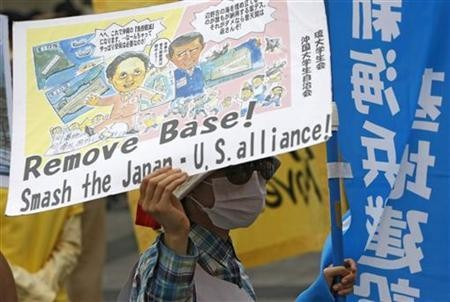U.S. Base Relocation In Japan Begins; Locals Protest
| Christl Leong | | Aug 14, 2014 02:02 PM EDT |
(Photo : REUTERS/Toru Hanai) Locals protest against U.S. bases in Okinawa in Naha, southern Okinawa. Photo taken on May 4, 2010.
The United States has placed buoys in Nago Bay, southern Okinawa Thursday, marking the beginning of a long-awaited plan to relocate its American base despite protests from locals in the area.
According to the Associated Press, the buoys indicate the location of the boring holes for a survey on the construction of an airstrip over the bay from Camp Schwab.
Like Us on Facebook
Soon thereafter, the construction of the U.S. Marine Corps Air Station Futenma will follow. The base will be transferred from a bustling neighborhood in Okinawa to coastal Henoko, with the entire project estimated to take at least five years.
Japanese media speculated the drilling could take place next week but both the U.S. and Japan governments gave no comment. Japan's Ministry of Defense did confirm that the buoys were positioned on Thursday, but declined to elaborate, citing security reasons.
Meanwhile, some 200 protesters gathered near the intended relocation site on Thursday bearing placards that read "No new base" and demanded a halt on the construction.
Protest organizer Hiroshi Ashitomi told the AFP that the relocation has disregarded the "feelings of Okinawan people." He vowed to continue the protests until the construction is stopped.
Japanese coast guard vessels were deployed on site as a precaution and intercepted the demonstrators' boats.
Local opposition with the U.S. bases has been going on for years, mostly due to accidents and crime reportedly caused by U.S. employees and military personnel.
In the last decade, the Japanese government has spent about US$3.7 million as compensation for the accidents and crimes committed, Channel News Asia reported.
Now, demonstrators claim the relocation in Henoko would harm biological marine life.
Nago mayor Susumu Inamine said the environmental assessments were not thorough.
"Pushing forward with this tramples on the human rights of the people, and the rich diverse natural life of this region," he added.
The relocation is part of a 1996 plan intended to reduce American military presence in crowded Okinawa.
The Japanese government has repeatedly stressed the role of the relocation plan in furthering ties with the U.S. amid concerns of heightening tensions with territorial rival China and of North Korea's nuclear program.
TagsUS base, Okinawa base, Marine Corps Air Station Futenma, MCAS Futenma, Henoko base
©2015 Chinatopix All rights reserved. Do not reproduce without permission
EDITOR'S PICKS
-

Did the Trump administration just announce plans for a trade war with ‘hostile’ China and Russia?
-

US Senate passes Taiwan travel bill slammed by China
-

As Yan Sihong’s family grieves, here are other Chinese students who went missing abroad. Some have never been found
-

Beijing blasts Western critics who ‘smear China’ with the term sharp power
-

China Envoy Seeks to Defuse Tensions With U.S. as a Trade War Brews
-

Singapore's Deputy PM Provides Bitcoin Vote of Confidence Amid China's Blanket Bans
-

China warns investors over risks in overseas virtual currency trading
-

Chinese government most trustworthy: survey
-

Kashima Antlers On Course For Back-To-Back Titles
MOST POPULAR
LATEST NEWS
Zhou Yongkang: China's Former Security Chief Sentenced to Life in Prison

China's former Chief of the Ministry of Public Security, Zhou Yongkang, has been given a life sentence after he was found guilty of abusing his office, bribery and deliberately ... Full Article
TRENDING STORY

China Pork Prices Expected to Stabilize As The Supplies Recover

Elephone P9000 Smartphone is now on Sale on Amazon India

There's a Big Chance Cliffhangers Won't Still Be Resolved When Grey's Anatomy Season 13 Returns

Supreme Court Ruled on Samsung vs Apple Dispute for Patent Infringement

Microsoft Surface Pro 5 Rumors and Release Date: What is the Latest?













